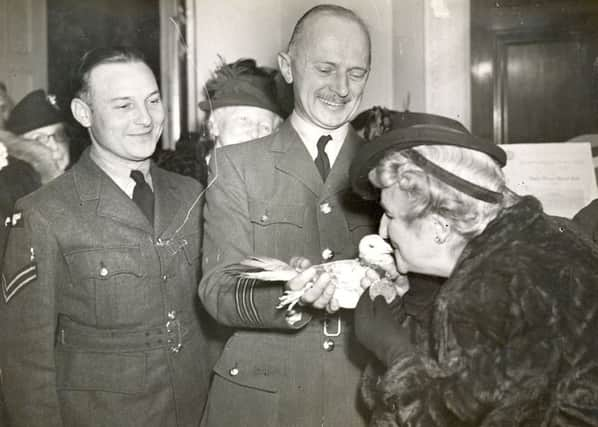Tweets from D-Day: How pigeons earned their wings


Thousands of pigeon fanciers gave their birds to the war effort to bring back news of how the troops were progressing during the Second World War.
This week world leaders will gather in France to honour the bravery and sacrifice of thousands of troops on D-Day 70 years ago. The culmination of a series of events marking the largest airborne and amphibious assault in military history will be held in Normandy on Friday.
Advertisement
Hide AdAdvertisement
Hide AdHeads of state from 17 nations, including the Queen, will gather for an international ceremony at Sword Beach, one of the five Allied landing beaches across a 50-mile stretch of Normandy coastline.
It was there that thousands of troops came ashore to help turn the tide of war into an eventual victory over Hitler’s Germany. And it was from near there that the first news report of the D-Day landings came from Gustav, an RAF homing pigeon released by the Reuters news agency correspondent Montague Taylor.
Taylor crossed the Channel with Allied forces and a number of birds to dispatch news of significant developments back to the office via the RAF.
The message which had been strapped to Gustav’s leg read: “We are just 20 miles or so off the beaches.
“First assault troops landed 0750. Signal says no interference from enemy gunfire on beach… Steaming steadily in formation.
“Lightnings, Typhoons, Fortresses crossing since 0545. No enemy aircraft seen.”
After Gustav travelled 150 miles across the Channel in five hours and 16 minutes to his pigeon loft at RAF Thorney Island in Hampshire with the message, and his handler, Sgt Harry Halsey, passed it to headquarters.
Gustav’s efforts earned him the PDSA Dickin Medal on 1 September, 1944, popularly regarded as the animal version of the Victoria Cross.
Advertisement
Hide AdAdvertisement
Hide AdThe citation read: “For delivering the first message from the Normandy Beaches from a ship off the beach-head while serving with the RAF on 6 June, 1944.”
Four pigeons, including Gustav, who delivered timely messages throughout Operation Overlord, along with one dog – an Alsatian called Brian – received the PDSA Dickin Medal for their actions on D-Day.
Another pigeon, Paddy – service number NPS.43.9451 – was honoured for the fastest recorded time for bringing a message from the Normandy operations.
During the Second World War, nearly 250,000 birds were used by the army, the RAF and the Civil Defence Services.
Pigeon racing was halted and birds of prey along Britain’s coastline were culled to enable the messenger pigeons to fly without coming to harm.
The PDSA Dickin Medal, instituted in 1943 by Maria Dickin, the founder of the UK veterinary charity, was awarded to animals to highlight their bravery in the line of fire.
Sixty-five of the medals have been awarded since 1943 – 32 of them to pigeons, 29 to dogs, three to horses and one to a cat.
• The words “Doom”, “Debarkation” and “Deliverance” have all been suggested as meanings for the “D” in D-Day.
Advertisement
Hide AdAdvertisement
Hide AdBut the letter simply comes from “Day” and means the day on which a military operation begins. D-Day has been used for many different operations but is most closely associated with the Normandy landings.